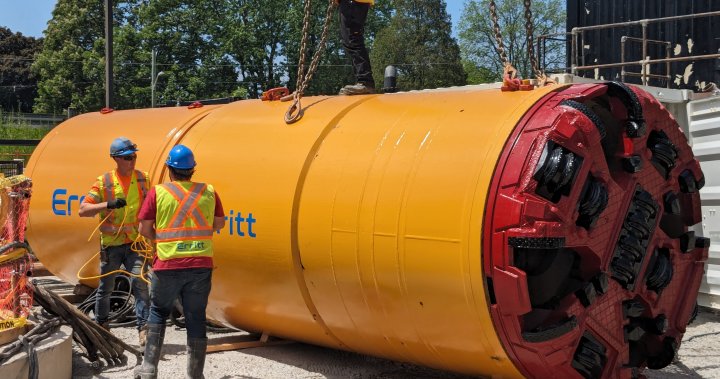An extensive project is underway in London to replace, re-route, and increase sewer capacity in the downtown area. The project, which is estimated to cost nearly $7.4 million, will involve replacing 800 meters of trunk sewer in total. The goal is to increase capacity to accommodate infill development in the downtown area, meet housing targets, and reduce overflows to the Thames River during wet weather events. Additionally, the project will tie into the West London Dyke reconstruction project, moving existing infrastructure out of the way for future developments.
To facilitate the project, a drill weighing more than 80,000 pounds has been brought to London. The drill, owned by Erritt Construction and valued at over $2 million, will be used to drill 6 meters below the ground for a total length of 68 meters under Wharncliffe Road. This process, known as microtunneling, is a trenchless technology that minimizes disruption to the road network, driveways, and surrounding areas. Once complete, the new pipe will be one of the largest in London. The entire project is anticipated to be completed by June 2025.
Matt Poulias, the site engineer for Erritt Construction, explained the operation of the drill during a safety demonstration. The machine operates by rotating its head and sending high-pressure water through feed nozzles to break up materials in front of it. The resulting slurry is then filtered in a separation plant before clean water is recirculated back to the drill. Mayor Josh Morgan, who was present at the construction site, emphasized the importance of the project for the city. He stated that the project will triple wastewater capacity from the downtown area to the Greenway Treatment Plant, allowing for residential densification in the core area and improved handling of heavy rainfalls.
The drilling operation is expected to take a few weeks to complete, with progress at a rate of approximately 15 centimeters per hour. Ashley Rammeloo, London’s director of water, wastewater, and stormwater, highlighted the significance of the project in terms of infrastructure improvement and environmental impact. By increasing sewer capacity and reducing overflows to the Thames River, the project aims to enhance the city’s infrastructure for future development and environmental sustainability. More information about the project can be found on the City’s Get Involved website, providing updates and details about the ongoing construction process.
Mayor Josh Morgan commended the construction process and the critical role that the project plays in enhancing the city’s infrastructure. The project’s completion will have far-reaching benefits for London, including increased wastewater capacity, improved residential densification in the downtown core, and enhanced resilience to heavy rainfalls. The project is part of a larger initiative to replace aging infrastructure, increase sewer capacity, and support future development in the downtown area. With a focus on minimizing disruption and maximizing efficiency through trenchless technologies like microtunneling, the project is expected to be completed by June 2025, providing long-term benefits for the community and the environment.
Keep Reading
Subscribe to Updates
Get the latest creative news from FooBar about art, design and business.
© 2025 Globe Timeline. All Rights Reserved.


